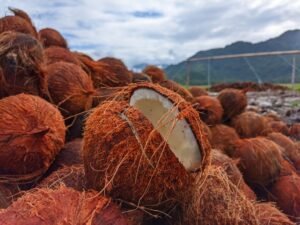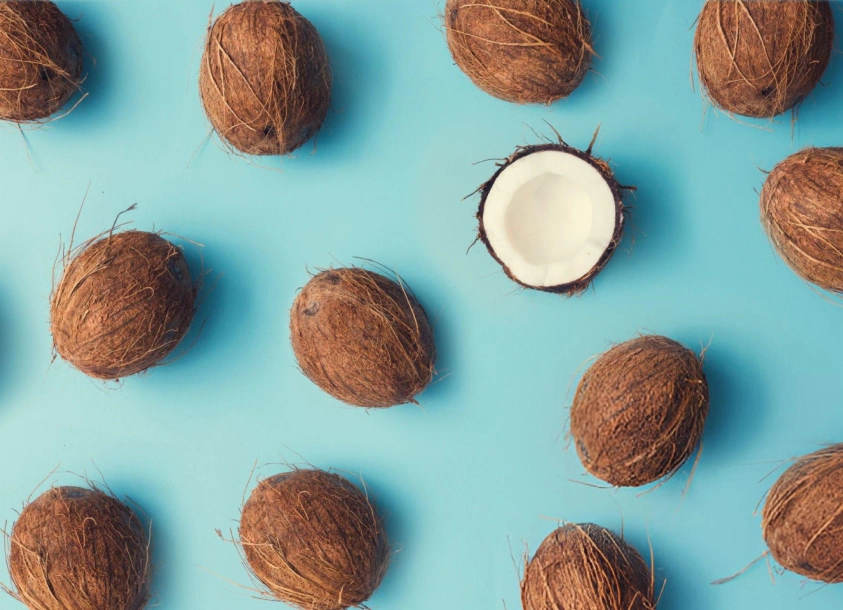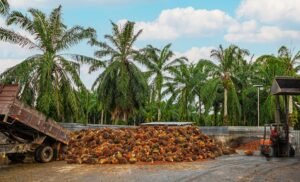
Indian Coconut Demand Surges in UK and Europe: Trends and Insights

Indian coconut demand is accelerating across the UK and European markets, reflecting a broader shift toward natural, plant-based products. With a rich history of coconut cultivation and export, India is well-positioned to meet this changing market demand. But what exactly is behind this surge in interest?
From regional buyer preferences to supply chain adaptation, we examine how the dynamics of the EU coconut trade are influencing global demand.
From regional buyer preferences to supply chain adaptation, we examine how the dynamics of the EU coconut trade are influencing global demand.
Understanding Indian Coconut Demand in Europe
The demand for Indian coconuts in the UK and the UK and Europe is rising steadily, driven by both consumer preferences and industrial applications. More specifically, there is an increasing interest in Indian coconut offerings, including whole coconuts, desiccated powder, and virgin oil, across the food, cosmetics, and health supplements industries.
A big one is the clean-label/minimally processed food trend. Coconut is also something that people have a naturally positive connotation with, and Indian varieties are associated with freshness and quality that is consistent. Coconut buyers from the UK and Europe also commend the solid growing base India provides, particularly in southern states like Tamil Nadu and Kerala.
The increase in coconut imports in the UK and Europe has encouraged more partnerships between distributors and Indian coconut suppliers. Whether for direct consumption or use in processing, Indian coconuts meet both traditional and emerging UK and European needs.
Indian exporters are responding not only with quantity but with structured supply chains that comply with the UK and European quality and safety benchmarks. The foundation of trust, built on consistent delivery and traceability, is helping sustain this momentum.
A big one is the clean-label/minimally processed food trend. Coconut is also something that people have a naturally positive connotation with, and Indian varieties are associated with freshness and quality that is consistent. Coconut buyers from the UK and Europe also commend the solid growing base India provides, particularly in southern states like Tamil Nadu and Kerala.
The increase in coconut imports in the UK and Europe has encouraged more partnerships between distributors and Indian coconut suppliers. Whether for direct consumption or use in processing, Indian coconuts meet both traditional and emerging UK and European needs.
Indian exporters are responding not only with quantity but with structured supply chains that comply with the UK and European quality and safety benchmarks. The foundation of trust, built on consistent delivery and traceability, is helping sustain this momentum.
Why the UK Prefers Indian Coconut Suppliers
The UK and European importers don’t just look at availability; they assess consistency, logistics, and adaptability. Here’s why Indian coconut suppliers are increasingly preferred:
- Reliable Year-Round Supply: India’s tropical climate ensures steady production throughout the year, making it easier for buyers to plan imports.
- Cost Advantage: Large-scale farming and proximity to export hubs like Tuticorin allow Indian exporters to offer competitive rates.
- Custom Packaging Options: Suppliers adapt packaging for EU food-grade, bulk, or retail-ready shipments.
- Traceability & Documentation: Exporters are aligned with the UK and European norms on labeling, origin traceability, and pesticide controls.
- Responsive to Market Needs: Suppliers customize product grades, moisture content, and cut sizes based on buyer specifications.
These factors contribute to a more integrated port-based coconut supply chain, reducing delays and ensuring buyers receive what they expect. India’s flexibility and focus on customer-specific requirements have made it a reliable partner for the UK and European retailers, distributors, and processors.
How Exporters Are Adapting to the New UK and European Market Trends
Indian exporters are now adapting their strategies to this evolving reality and the needs of the UK and European buyers. It is not just an operational shift, but a strategic one. As a result, exporters are beginning to work towards better technologies and sustainability to comply with the UK and Europe’s regulations and consumers.
Food safety compliance is one such fundamental area that can improve. Exporters are also including tests for microbial contamination and pesticide residues, which are required for clearance in high-regulation areas such as Germany or France. Also, exporters are seeking third-party certifications that are relevant in EU markets, like BRC, Global GAP, and Organic certifications.
Equally interesting is the shift towards smarter logistics. Efficiency of routes and also agility in customs proceedings are given by exporters preferring to export through port cities that require a smaller distance to cover. For instance, shipments from Tuticorin port, coconut shipments, are optimized for Western Europe delivery with minimum lag time.
In general terms, Indian suppliers of coconut are not only meeting the demand but are also creating this alignment in terms of increasing standards and expectations from Europe.
Food safety compliance is one such fundamental area that can improve. Exporters are also including tests for microbial contamination and pesticide residues, which are required for clearance in high-regulation areas such as Germany or France. Also, exporters are seeking third-party certifications that are relevant in EU markets, like BRC, Global GAP, and Organic certifications.
Equally interesting is the shift towards smarter logistics. Efficiency of routes and also agility in customs proceedings are given by exporters preferring to export through port cities that require a smaller distance to cover. For instance, shipments from Tuticorin port, coconut shipments, are optimized for Western Europe delivery with minimum lag time.
In general terms, Indian suppliers of coconut are not only meeting the demand but are also creating this alignment in terms of increasing standards and expectations from Europe.
Top European Markets Driving Coconut Export Growth
Some of the most influential demand zones for Indian coconut exports lie across Western and Central Europe. Here’s a breakdown of the key players in the EU coconut trade:
- Germany: Strong demand for organic and desiccated coconut across food and cosmetic sectors.
- Netherlands: A logistics and warehousing hub for coconut redistribution across the EU.
- France: Strong demand for organic and desiccated coconut across food and cosmetic sectors
- Italy & Spain: Expanding markets for coconut water and coconut-based bakery ingredients.
- Poland & Czech Republic: Newer entrants, growing in demand due to rising plant-based food trends.
As European coconut buyers diversify their product sourcing, Indian exporters are forming country-specific strategies to tailor supply, packaging, and documentation to each market. These regional trends signal a wider acceptance of Indian coconuts in both mainstream and niche retail chains, opening up opportunities for sustained export growth.
Challenges Indian Exporters Must Navigate
Even with growing demand, Indian exporters encounter several difficulties in accessing or growing in the European market. Complex regulation is one of them. There is a clear and strict protocol within the EU in regards to pesticide residue, food safety, and import documentation. Compliance requires a huge investment in these systems and certifications.
Buyers are also asking for transparency in carbon footprint, packaging waste, and not only sourcing. Exporters are being incentivized to adopt biodegradable practices and report sustainability in their supply chain.
Logistical concerns represent another challenge. While coconut exporters are, in any case, near the coconut-producing regions thanks to their proximity to Indian ports such as Cochin, global fluctuations in freight costs and container shortages can affect timelines, impacting the fast delivery that India is known for in coconut products.
Ultimately, exporters are being forced to diversify and decouple their logistics and processing centers to be able to better handle shocks to the market and regulatory changes, despite these challenges.
Buyers are also asking for transparency in carbon footprint, packaging waste, and not only sourcing. Exporters are being incentivized to adopt biodegradable practices and report sustainability in their supply chain.
Logistical concerns represent another challenge. While coconut exporters are, in any case, near the coconut-producing regions thanks to their proximity to Indian ports such as Cochin, global fluctuations in freight costs and container shortages can affect timelines, impacting the fast delivery that India is known for in coconut products.
Ultimately, exporters are being forced to diversify and decouple their logistics and processing centers to be able to better handle shocks to the market and regulatory changes, despite these challenges.
What Opportunities Lie Ahead for Indian Coconut Exporters?
Even with obstacles, there’s considerable room for coconut export growth from India to Europe. Exporters that act proactively will benefit from a demand-rich, value-conscious customer base. Here’s where the opportunities lie:
- Growth in Vegan & Plant-Based Markets: Coconut serves as a dairy alternative in drinks, desserts, and snacks.
- Private Label Retailers: Many EU retailers are sourcing directly from Indian suppliers for store-brand products.
- E-commerce Distribution: Online sellers are sourcing packaged coconut products, offering a new channel for exporters.
- Functional Foods: Health-oriented products like coconut flour, chips, and low-sugar desserts are opening up new B2B deals.
- Sustainability Partnerships: Exporters offering low-impact farming methods and plastic-free packaging stand to gain more trust.
These emerging channels give exporters the ability to build deeper and more profitable relationships with European partners, not just as vendors but as long-term collaborators.
Strengthening India's Position in the European Coconut Market
The rising Indian coconut demand across Europe reflects a broader transition towards clean, sustainable, and transparent sourcing. Indian coconut suppliers upgraded their compliance level, packaging, and shipping in response. Regulatory and freight issues are still challenges, but the future looks positive in the long term.
If they remain flexible and adapt to the specific needs of each market, Indian exporters will be well-positioned to increase their penetration in the EU coconut trade as well as meet the changing demands of Europe’s coconut consumers. Thus, Europe presents an opportunity for India to become a value-added and customer-driven leader in coconut exports, if a proper strategy is adopted.
Lorem ipsum dolor sit amet consectetur.
Lorem ipsum dolor sit amet consectetur. Consequat vulputate convallis eget mollis viverra nunc mi egestas. Risus facilisi nullam donec.


